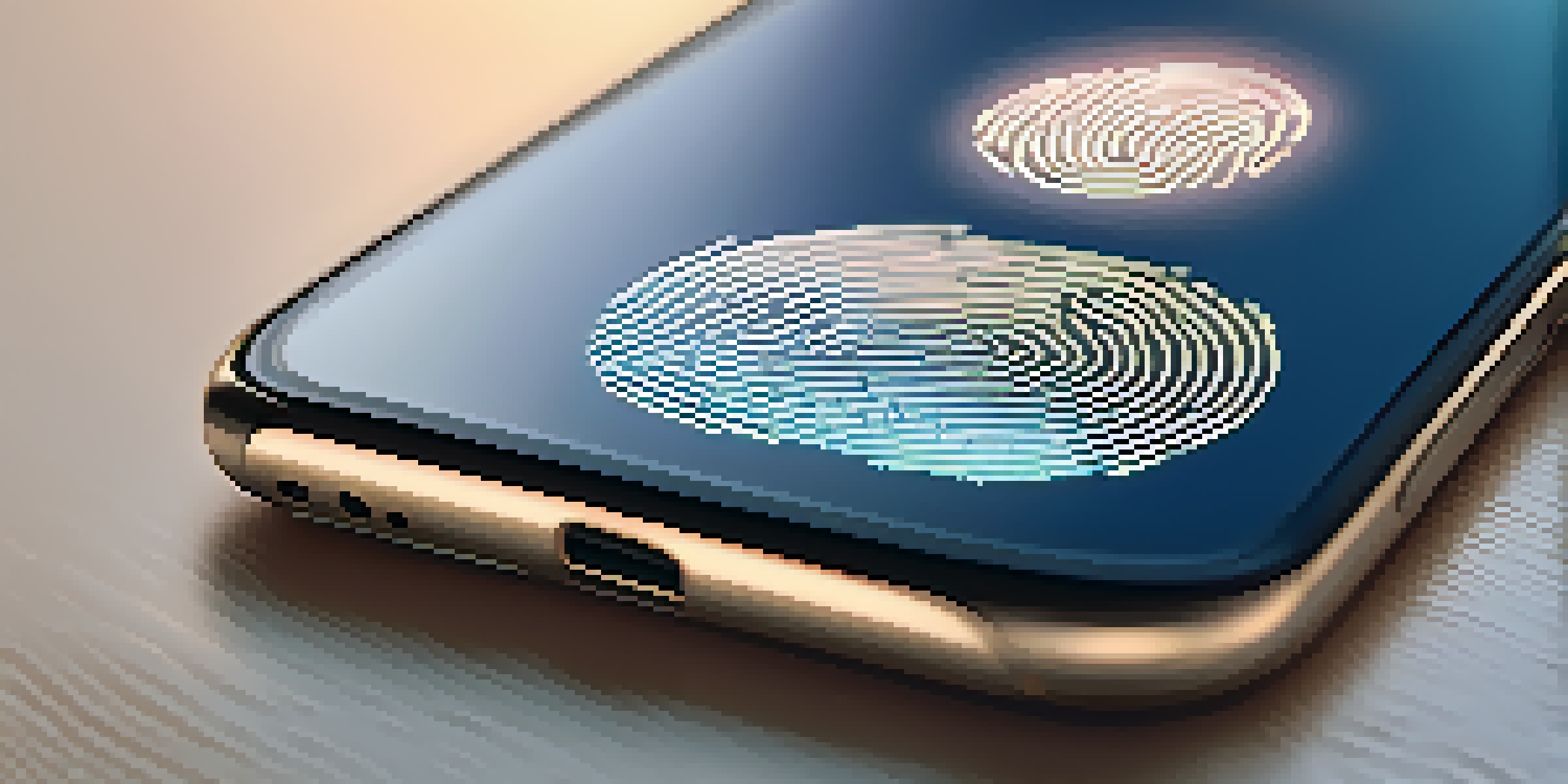The Role of Biometrics in Modern Mobile Devices

Understanding Biometrics and Its Importance
Biometrics refers to the measurement and statistical analysis of people's unique physical and behavioral characteristics. In the realm of mobile devices, this technology plays a crucial role in enhancing security and user experience. By allowing devices to recognize users through fingerprints, facial recognition, or voice patterns, biometrics provides a level of authentication that passwords simply can't match.
Biometrics is the science of recognizing individuals based on their unique physical and behavioral traits.
The importance of biometrics extends beyond mere convenience; it also addresses privacy concerns. As our devices hold more personal information, ensuring that only authorized users can access this data becomes paramount. Biometrics offers a robust solution by tying access to physical traits that are unique to each individual, reducing the risk of unauthorized access.
Furthermore, as cyber threats become increasingly sophisticated, it's essential for mobile devices to leverage advanced security measures. Biometrics can adapt to evolving threats, making it an effective shield for sensitive information. This evolution not only protects users but also builds trust in mobile technology as a secure platform.
How Fingerprint Recognition Works
Fingerprint recognition is one of the most common biometric methods used in mobile devices today. When you place your finger on a scanner, it captures an image of your fingerprint and converts it into a digital template. This template is then stored securely on the device, allowing for quick and accurate identification whenever you unlock your phone.

The technology behind fingerprint scanners has improved significantly over the years. Modern devices often use capacitive or optical sensors, which are capable of capturing high-resolution images of fingerprints. This advancement means that even minor details of your fingerprint can be analyzed, making it incredibly difficult for someone to spoof your identity.
Biometrics Enhance Security
Biometric technologies like fingerprint and facial recognition provide advanced authentication methods that significantly improve device security.
Moreover, the convenience of fingerprint recognition cannot be overstated. It allows users to unlock their devices swiftly and securely, making it a preferred choice for many. As more apps adopt fingerprint authentication for transactions, it enhances both security and user experience, turning a mundane task into a seamless interaction.
Exploring Facial Recognition Technology
Facial recognition technology has gained traction in recent years, allowing mobile devices to identify users by analyzing facial features. This method uses advanced algorithms to map the unique characteristics of a person’s face and create a digital representation. When you look at your phone, it compares your face to this digital template to grant access.
As technology evolves, the integration of biometrics into our daily lives will redefine how we think about security and privacy.
What makes facial recognition particularly appealing is its hands-free functionality. Users can unlock their devices simply by looking at them, which is not only convenient but also hygienic—a crucial factor in today's world. Additionally, many smartphones now incorporate 3D mapping to enhance accuracy, making it even more difficult for someone to unlock your device with a photo.
Despite its advantages, facial recognition does raise some concerns regarding privacy and security. For instance, there are ongoing discussions about how facial data is stored and used. However, with proper safeguards and regulations, facial recognition can be a powerful tool for enhancing security while maintaining user convenience.
The Role of Voice Recognition in Mobile Security
Voice recognition is another fascinating biometric technology that has found its way into modern mobile devices. This method analyzes the unique patterns in a person's voice, including pitch, tone, and cadence, to verify their identity. As a result, users can access devices and apps simply by speaking, which adds an entirely new layer of convenience.
One of the major benefits of voice recognition is its accessibility. It allows individuals with physical disabilities to interact with their devices more easily, demonstrating how biometrics can enhance inclusivity. Additionally, voice commands can streamline tasks, such as sending messages or making calls, making mobile technology even more user-friendly.
Convenience in Mobile Payments
Integrating biometrics with mobile payment systems allows users to authorize transactions quickly and securely with a simple touch or glance.
However, voice recognition isn't without its challenges. Environmental noise and variations in voice due to illness can affect accuracy. Nonetheless, as machine learning continues to evolve, the reliability of voice recognition is improving, making it a viable option for secure mobile access in the near future.
The Integration of Biometrics in Mobile Payments
Biometrics has transformed the mobile payment landscape, providing a secure and efficient way to conduct transactions. By linking payment apps to biometric features like fingerprints or facial recognition, users can authorize payments with a simple touch or glance. This not only speeds up the payment process but also enhances security, reducing the risk of fraud.
As more consumers embrace contactless payments, biometrics offers peace of mind when making purchases. The fear of stolen credit card information or identity theft diminishes when transactions are tied to unique physical traits. This growing trust in biometric payments is evident in the rising popularity of services like Apple Pay and Google Pay, which prioritize user security.
Moreover, as businesses adopt biometric payment solutions, they are also enhancing customer loyalty. Offering secure and seamless transactions can improve the overall shopping experience, encouraging customers to return. As this trend continues, we can expect to see further innovations in how biometrics integrates with mobile payments.
Challenges and Limitations of Biometric Systems
While biometrics offers numerous advantages, it's essential to recognize the challenges that come with it. One major concern is the risk of biometric data being stolen. Unlike passwords, which can be changed, biometric traits are permanent. If someone gains access to your fingerprint or facial data, the consequences can be severe, leading to identity theft or unauthorized device access.
Another limitation is the potential for false positives or negatives during the recognition process. Environmental factors, such as lighting conditions for facial recognition or moisture for fingerprint scanners, can impact accuracy. As a result, there might be instances where legitimate users are denied access, leading to frustration and a lack of trust in the technology.
Challenges of Biometric Systems
Despite their advantages, biometric systems face challenges such as data theft risks and accuracy issues that need to be addressed for broader adoption.
Despite these challenges, the industry is actively working on solutions to mitigate these risks. Enhanced encryption methods, multi-factor authentication, and continual improvements in biometric algorithms are just a few strategies being implemented to bolster security. By addressing these limitations, the future of biometrics in mobile devices looks promising.
The Future of Biometrics in Mobile Devices
The future of biometrics in mobile devices is incredibly exciting, with advancements paving the way for more secure and user-friendly experiences. As technology evolves, we can expect to see a wider variety of biometric methods, including iris recognition and palm scanning, becoming mainstream. These innovations will offer users even more options for secure authentication.
Moreover, the integration of artificial intelligence (AI) with biometrics holds great potential. AI can analyze user behaviors and preferences, allowing for adaptive security measures that enhance both convenience and protection. For instance, a device could recognize when a user is in a familiar environment and adjust security settings accordingly.

Ultimately, the goal is to create a seamless experience that prioritizes user security without compromising convenience. As more consumers demand secure access to their devices and personal data, biometrics will continue to play a pivotal role in shaping the future of mobile technology.